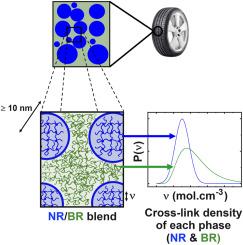硫化天然橡胶/丁二烯橡胶共混物的固态核磁共振:局部组织和交联异质性
引用次数: 0
摘要
弹性体混合物,其中包括天然橡胶(NR)和丁二烯橡胶(BR),涉及汽车/轮胎工业的许多部件。要全面了解它们的机械性能,除其他特征外,还需要对这些混合物中的交联密度进行详细描述。在硫化不相溶混合物中,富含 NR 和 BR 的每个畴内的交联密度分布是关键信息,但很难用单组分交联弹性体的传统方法来确定。在本研究中,我们使用稳健的 1H 双量子 (DQ) MAS 重耦合实验(BaBa-xy16)研究了 NR/BR 共混物内部的硫化情况。研究考虑了两种交联 NR/BR 共混物,其中 BR 成分具有两种不同的微观结构。首先,通过分析 1H 自旋晶格弛豫行为来探测所得到的混合物的体组织。第二步,使用 BaBa-xy16 选择性地研究 NR/BR 共混物内部的交联异质性。特别是对于不相溶的 NR/BR 混合物,对两相之间的交联密度分布进行了比较,并对观察到的差异进行了讨论。本文章由计算机程序翻译,如有差异,请以英文原文为准。

Solid-state NMR of vulcanized natural rubber/butadiene rubber blends: Local organization and cross-linking heterogeneities
Elastomer blends, among which natural rubber (NR) and butadiene rubber (BR), are involved in many components of the automotive/tire industry. A comprehensive understanding of their mechanical behavior requires, among other features, a detailed description of the cross-link density in these mixtures. In the case of vulcanized immiscible blends, the distribution of the cross-link density within each of the NR- and BR-rich domains is key information, but difficult to determine using the conventional approaches used for one-component cross-linked elastomers. In this study, the vulcanization within NR/BR blends is investigated using a robust 1H double-quantum (DQ) MAS recoupling experiment, BaBa-xy16. Two kinds of cross-linked NR/BR blends were considered with two different microstructures for the BR component. The bulk organization of the resulting blends was first probed by analyzing the 1H spin-lattice relaxation behavior. In a second step, BaBa-xy16 was used to investigate, in a selective way, the cross-link heterogeneities within NR/BR blends. In particular, for immiscible NR/BR mixtures, the distribution of the cross-link density between both phases was compared and the observed differences were discussed.
求助全文
通过发布文献求助,成功后即可免费获取论文全文。
去求助
来源期刊

Magnetic Resonance Letters
Analytical Chemistry, Spectroscopy, Radiology and Imaging, Biochemistry, Genetics and Molecular Biology (General)
自引率
0.00%
发文量
0
 求助内容:
求助内容: 应助结果提醒方式:
应助结果提醒方式:


